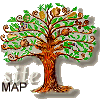| SITE INSPECTION
 A preliminary step in any recording project is the initial site visit. Equipped with tape measure, sketching gear, flashlight and penknife, the recorder sets out on a systematic tour of the entire premises, the object being to observe and note down briefly the design, materials and present condition of the building. Since the history of the structure is important, attention is paid to signs of past alterations and additions. Quite often the exploration of roof and crawl spaces will yield such clues as, for example, changes in framing patterns, timber sizes or species, modifications to chimneys and masonry, or traces of old construction as indicated by nail holes or dirt marks, which will be useful in piecing together the history of the structure. Structural movements, such as leaning walls or sagging eaves and floors, can be checked visually and noted, as should signs of dampness and decay. Careful probing with a knife will reveal where deterioration has occurred. A preliminary step in any recording project is the initial site visit. Equipped with tape measure, sketching gear, flashlight and penknife, the recorder sets out on a systematic tour of the entire premises, the object being to observe and note down briefly the design, materials and present condition of the building. Since the history of the structure is important, attention is paid to signs of past alterations and additions. Quite often the exploration of roof and crawl spaces will yield such clues as, for example, changes in framing patterns, timber sizes or species, modifications to chimneys and masonry, or traces of old construction as indicated by nail holes or dirt marks, which will be useful in piecing together the history of the structure. Structural movements, such as leaning walls or sagging eaves and floors, can be checked visually and noted, as should signs of dampness and decay. Careful probing with a knife will reveal where deterioration has occurred.
 Within each room of the building note should be taken of the finishes and detail. These include the flooring, baseboards, wainscotting, picture rails, cornices, windows and doors and their trim, fireplaces, mantels and any special structural or decorative features. It is important to note the complexity and the repetitiveness of design of these elements. It is wise at this point to take enough dimensions, e.g. length and width of principal rooms, ceiling heights, typical window and sill heights, and overall exterior dimensions, to allow the drafting of a set of rough floor plans. These will be valuable in organizing one's observations and in planning the number, type and scale of the drawings in the contemplated recording program. Within each room of the building note should be taken of the finishes and detail. These include the flooring, baseboards, wainscotting, picture rails, cornices, windows and doors and their trim, fireplaces, mantels and any special structural or decorative features. It is important to note the complexity and the repetitiveness of design of these elements. It is wise at this point to take enough dimensions, e.g. length and width of principal rooms, ceiling heights, typical window and sill heights, and overall exterior dimensions, to allow the drafting of a set of rough floor plans. These will be valuable in organizing one's observations and in planning the number, type and scale of the drawings in the contemplated recording program.
|
 |
 The recorder should also inspect the exterior. Note should be taken of the number and types of windows and doors, the exterior cladding, the eave details, the roof design and roofing materials, the chimneys, and the extent and type of decorative detail. The recorder should also inspect the exterior. Note should be taken of the number and types of windows and doors, the exterior cladding, the eave details, the roof design and roofing materials, the chimneys, and the extent and type of decorative detail.
 Before leaving the site, the boundaries of the survey should be considered. If a survey of the site is to be included as a part of the drawings, note should be taken of the contours, the number of trees and any other features which will be of importance in the land survey. Before leaving the site, the boundaries of the survey should be considered. If a survey of the site is to be included as a part of the drawings, note should be taken of the contours, the number of trees and any other features which will be of importance in the land survey.
 The gathered information is then sorted and grouped in logical categories. The recorder will find it useful to consider the following questions, and is referred to the section on Techniques for further information on answering them: The gathered information is then sorted and grouped in logical categories. The recorder will find it useful to consider the following questions, and is referred to the section on Techniques for further information on answering them:
- What are the logical boundaries of the survey?
- What are the most appropriate survey methods for defining the configuration of the building?
- What are the best survey methods for delineating the details of the building? Are specialized techniques such as photogrammetry called for?
- Will the site survey require the services of a professional land surveyor? Is a surveyor needed to establish gridlines or to define the exterior shape of the building(s)?
- How many plans, elevations and sections will be needed to delineate the building? What are appropriate scales? Will these views fit on the standard drawing sheets?
- How many detail drawings are required? How many types of detail are there and how much variation is there within each type?
- What are the practical problems of access (interior and exterior) for measurement, lighting and facilities for the measuring crew?
|








